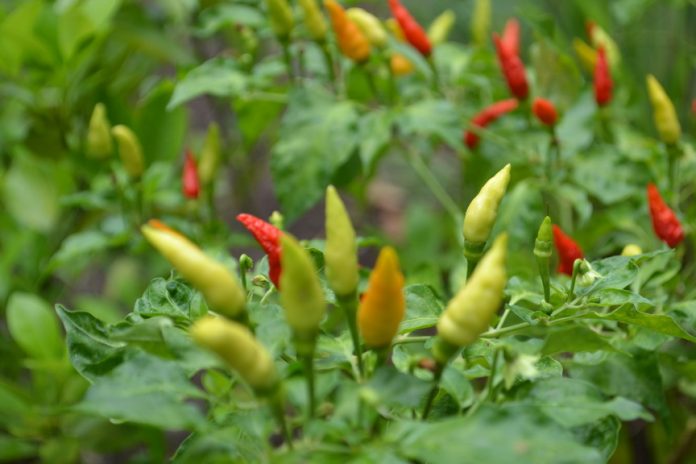Scientifically, it is known as Capsicum frutescens. In most English-speaking countries, it is called chili (other spellings include chilli and chile) or hot pepper. But among Filipinos, it is popularly known simply as sili.
It is estimated that one in four people eats chilis every day, according to Reader’s Digest intrepid reporter Robert Kiener. “Chillis were first domesticated in South America, in what is now Bolivia, some 6000 years ago,” he wrote. “Incas called the spicy fruit aji, and the Aztecs changed it to chilli.”
It was Christopher Columbus who brought the spice to Europe in the late 1400s. Portuguese and Spanish traders introduce the crop to Africa and Asia, where it became such a hit that locals soon viewed the import as their own.
Today, chili peppers are used around the world to make a countless variety of sauces, known as hot sauce, chile sauce, or pepper sauce. Indian cooking has multiple uses for it — from simple snacks to wonderfully complex curries. It is dried, roasted and salted as a side dish for rice varieties. Sambal is a versatile relish made from chili peppers as well as other ingredients such as garlic, onion, shallots, salt, vinegar and sugar, which is popular in Indonesia and Malaysia.
In Italian cuisine, crushed chili pepper flakes are a common ingredient on pizza, among other things. The leaves, mildly bitter but not nearly as hot as the fruits that come from the same plant, are cooked as vegetable in Filipino cuisine, where they are used in the chicken soup (tinola). In Korean cuisine, the leaves may be used in kimchi.
Some chili peppers are not grown for eating but for their decorative qualities. The Medusa pepper, for instance, produces fruit starting purple and then ripens to yellow, orange, and finally red. Black Pearl pepper has black leaves and round black fruit that ripen to a bright red.
Ripe chilis contain high amounts of vitamin C and carotene. Unripe fruits contain a considerably lower amount of both substances. In addition, chili peppers are a good source of most B vitamins, and vitamin B6 in particular. They are very high in potassium, magnesium, and iron. (The leaves are excellent sources of calcium, and iron and a good source of phosphorus, vitamin B, and vitamin A.)
However, chili peppers get their kick from a chemical called capsaicin located in the inside wall of the pepper pod. Capsaicin is reportedly about 100 times hotter than the active principle piperine of black pepper. In an article, Rico R. Magda wrote: “The compound capsaicin is almost insoluble in water and needs to be emulsified if used in food. Capsaicin extracted by organic solvent becomes gummy or oily syrup when concentrated.”
An aerosol extract of capsaicin, usually known as pepper spray has become widely used by police forces as a non-lethal means of incapacitating a person and in more widely dispersed for riot control, or by individuals for personal defense.
In medicine, capsaicin has been found to be a safe and effective analgesic agent in the management of arthritis pain, herpes zoster-related pain, diabetic neuropathy, post-mastectomy pain, and headaches.
Research in humans found that “after adding chili to the diet, the LDL (or bad cholesterol), actually resisted oxidation for a longer period of time, (delaying) the development of a major risk for cardiovascular disease.” Another research found that the amount of insulin required to lower blood sugar after a meal is reduced if the meal contains chili pepper. Chili peppers are also being probed as a treatment for alleviating chronic pain.
Scientists at Germany’s Max Planck Institute claim chili peppers may prevent formation of blood clots. Chili peppers can also ease the symptoms of the common cold by breaking up congestion and reducing mucus.
Recent studies have also discovered capsaicin could have an anti-ulcer protective effect on stomachs. Dr. Jin Y. Kang, of the National University Hospital in Singapore, said that chili does not harm the stomach of people suffering from peptic ulcers. It may even help, he added.
“It seems like there’s no end to chilli peppers’ versatility,” points out Dr. Danise Coon, program coordinator of New Mexico State University’s Chili Pepper Institute.
Now, the other side of the coin. Unknowingly, chili may increase the number of daily bowel movements and lower pain thresholds for people with irritable bowel syndrome. Consumption of red chilis after anal fissure surgery should be forbidden to avoid postoperative symptoms.
Experts cautioned not to swallow the whole chili pepper; there are cases where unchewed chilis have caused bowel obstruction and perforation. Chronic ingestion of chili products may likewise induce gastroesophageal reflux.
Because of their sheer popularity and ease of cross-pollination, there are now thousands of chili pepper varieties around the world. And the mighty mite, wild Philippine chili is one of the hottest spices on earth. It is locally known as siling labuyo because of its strong, hot taste that Filipinos relate to the brave variety of red rooster.
“Siling labuyo capsule is small and tapers at the tip,” Magda wrote. “Some say it looks like the Tabasco chili and equate it as the same species. Actually, three types of siling labuyo exist which vary in length from 1.5 to 2.5 centimeters. The smallest, less than or about 1.5-centimeters long, is the hottest of them all. The remarkably small but very pungent fruit is good for those food adventurers with galvanized gullets.”
According to the Department of Agriculture, chili pepper can be grown from low to wind elevation throughout the year. Production is best, however, during the cool, dry months of October to March in sandy loam soil (with pH of 5.5 to 6.5).







